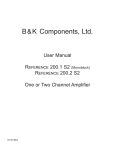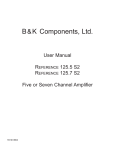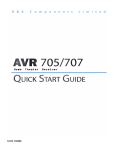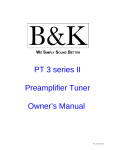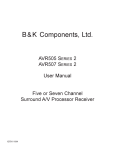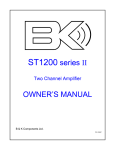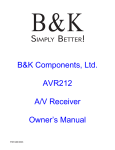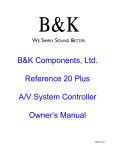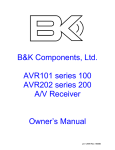Download B&K AV2600 User's Manual
Transcript
B&K SIMPLY BETTER! B&K Components, Ltd. AV2600 Owner’s Manual P/N12930 0802 B&K Components, Ltd., 2100 Old Union Road, Buffalo New York 14227-2725 Phone 1-800-543-5252 or (716) 656-0026, Fax (716) 656-1291 E-mail: [email protected] Web: www.bkcomp.com ii TABLE OF CONTENTS Table of Contents...................................................................................................................................iii Safety Precautions .................................................................................................................................1 Purpose and Function ............................................................................................................................2 Features ...................................................................................................................................................2 Rear Panel View ......................................................................................................................................3 DIP Switch Setting ..................................................................................................................................4 Channel Control & Muting......................................................................................................................5 Master Control & Muting ........................................................................................................................5 Level Control ...........................................................................................................................................5 Input Connections ..................................................................................................................................6 Output Connections ...............................................................................................................................6 Level Control Defeat ...............................................................................................................................7 Jumper Settings......................................................................................................................................7 High Current (Mono) Usage ...................................................................................................................8 System Installation .................................................................................................................................9 Making the Connection ..........................................................................................................................9 Troubleshooting....................................................................................................................................10 Care and Cleaning ................................................................................................................................10 Specifications .......................................................................................................................................11 Limited Warranty..................................................................................................................................................................12 Returning Equipment ............................................................................................................................................................12 WWW.BKCOMP.COM ...........................................................................................................................13 iii SAFETY PRECAUTIONS PLEASE READ BEFORE INSTALLING WARNING: to prevent fire or shock hazard, do not expose this unit to rain or moisture. Care should be taken to prevent objects or liquid from entering the enclosure. Never handle the power cord with wet hands. • The lightning flash with arrowhead, within an equilateral triangle, is intended to alert the user of the presence of uninsulated “dangerous voltage” within the product’s enclosure that may constitute a risk of electric shock to you. • The exclamation point within an equilateral triangle is intended to alert the user of the presence of important operating and maintenance (servicing) instructions in the literature accompanying the unit. • Caution: To prevent the risk of electric shock, do not remove cover. No user-serviceable parts inside. Refer servicing to qualified service personnel. • Unplug the amplifier from the AC outlet when plugging in or unplugging cables, when left unused for an extended period of time, moving the amplifier, or when you suspect lightning in your area. • Prevent damage to the power cord. Do not bend, pull, place objects on, alter, etc. Replace the power cord if it becomes damaged. Always grasp the plug on the power cord when plugging in or unplugging the amplifier from the AC outlet. • Your system may produce sound levels capable of causing permanent hearing loss. Do not operate for extended periods of time at high volume levels. • Make sure the amplifier is placed on a level surface. • The amplifier is equipped with raised feet to provide ventilation, reduce acoustic feedback, and provide protection against scratching the surface the unit is resting on. We advise against removing or altering feet. • Do not stack anything on top of the amplifier (processor, source, etc.) Leave a minimum of 2” clearance from the top of the amplifier to the next shelf (or component) to insure proper ventilation. • The amplifier should be located away from other sources that may be sensitive to heat. • Do not perform any internal modifications to the amplifier. • Always connect the amplifier’s power cord to an unswitched AC outlet for normal operation. • If young children are present, adult supervision should be provided until the children are capable of following all rules for safe operation. • Do not plug the amplifier’s power cord into an outlet with an unreasonable number of other devices. Be careful if using extension cords and ensure the total power used by all devices does not exceed the power rating (watts/amperes) of the extension cord. Excessive loads may cause the insulation on the cord to heat and possibly melt. • Mistaking CONTROL OUTPUT or CONTROL INPUT connectors for audio/video inputs or outputs may damage your amplifier or other components. • Damage can occur to your speakers if the power rating of each individual driver is exceeded by the amplifier. Ensure that all the drivers in your system are capable of handling not only the average power being delivered by the amplifiers, but also the peak power that is likely to be generated during strong passages. If you are unsure of your speaker's power rating, contact the speaker manufacturer or the dealer where you purchased them. • The amplifier should be serviced by qualified personnel when: A. The amplifier is not functioning properly. B. Objects have entered the chassis. C. The amplifier was exposed to rain or other type of moisture. D. The amplifier was dropped, or the chassis is damaged. 1 PURPOSE AND FUNCTION The AV2600 is an integration of a stereo audio distribution BUS with six compact and efficient 60 W power amplifiers. Each pair of amplifiers have DIP switches that allow system configuration for use with either mono/stereo and muting control via a Master or Local control input. Additionally, there is support for paralleling multiple speaker output channels to allow greater output current capability. It is clear the AV2600 is designed to allow flexibility and functionality in the design of Multi Zone power system applications. The term versatile is almost inadequate to describe the multitude of operational modes the AV2600 is capable of providing. Below are just a few of the tasks the AV2600 may be configured to perform: • The most obvious example allows for three stereo audio input pairs to power three pairs of amplified speaker outputs. This is the default factory configuration. • Using the audio distribution BUS, DIP switches allow independent configuration for up to 3 pairs of mono or stereo, with independent automatic audio sense muting per amplifier output pair. • The availability of both Local and BUS audio outputs, allows for a number of units to be cascaded for easy and efficient system expansion. FEATURES Toroidal Transformer - Efficient high current power delivery for improved dynamics. Computer Grade Capacitors - Large capacity computer grade electrolytic capacitors for high transient power delivery and extended low frequency control. Limited Protection - Increased Safe Operating Area and thermal overload allows for continuous duty unattended use. Gold Plated Connectors - Improved connections for better sound and minimized signal loss and degradation. 1% Metal Film Resistors - Low noise precision resistors offer a cleaner more repeatable sound quality. High Current Circuitry - More accurate and three dimensional reproduction of source material with sonic fidelity usually found only in larger power amplifiers. 2 REAR PANEL VIEW 2 1 SERIAL NUMBER CTRL 5/6 OUT OUT 5 IN IN OUT 6 IN LEVEL 5/6 BUS L+R SENSE AMP ON 3 CTRL 3/4 OUT OUT 3 IN IN OUT 4 IN LEVEL 3/4 BUS L+R SENSE AMP ON 4 CTRL 1/2 OUT OUT 1 IN IN OUT 2 IN 5 6 LEVEL 1/2 BUS L+R SENSE AMP ON 7 MASTER CONTROL OUT IN BUS OUT IN IN OUT FUSE CAUTION: FOR CONTINUED PROTECTION AGAINST RISK O F F I R E R E P L A C E O N LY W I T H S A M E T Y P E 1 5 A 2 5 0 V. ON MIN OUT 6 MAX ON MIN 1 2 3 4 OUT 5 MAX OUT 4 1 ON MIN 2 3 4 OUT 3 MAX 1 2 3 4 OUT 2 OUT 1 A.C.LINE VOLTAGE MINUS PLUS MINUS PLUS MINUS PLUS 8 MINUS PLUS MINUS PLUS MINUS PLUS 9 Figure 1 1. AC fuse holder 2. Channel control input/output 3. Dip switches 4. Channel inputs and outputs 5. Channel level control 6. Master control input/output 7. Bus inputs and outputs 8. AC input receptacle 9. Speaker outputs 1. AC fuse holder - The AC Line fuse. The fuse is an 8 Amp / 250 Volt Slow Blow fuse. Replace with same type and value fuse only. 2. Channel control input/output - Each pair of amplifier channels has its own 1/8” mini control input / output (pass through) ‘Local’ control jack to provide remote switching of the amplifier audio mute on/off feature. The control input circuit is designed to work as Tip Pos. (+) and Ring Neg. (-). A minimum of 5VDC @ 1 mA is recommended, and is compatible with up to 24V AC or DC. 3. Dip switches - Each pair of amplifier channels has its own DIP switches that are used to configure the audio signal (‘Local’ or ‘BUS’, mono or stereo and muting control). 4. Channel inputs and outputs - Each pair of amplifier channels has its own ‘Local’ set of audio input / output (pass through) RCA connections. Typically used for connecting signal patch cables (interconnects) from the preamplifier to the amplifier. 5. Channel level control - Each pair of amplifier channels has its own DUAL input level control. The level of both amplifier channels is set via this control. 6. Master control input/output - The AV2600 is designed to provide control for single switching of the amplifier audio mute on/off feature on any pair of amplifier channels (1-2, 3-4 or 5-6) with it’s DIP switch ‘MASTER’ set to ON. The control input circuit is designed to work as Tip Pos. (+) and Ring Neg. (-). A control source capable of sourcing a minimum of 5 VDC @ 1 mA is recommended, and is compatible with up to 24V AC or DC. (The Master control output DOES NOT source any voltage directly, it will only PASS through the input voltage at it’s input). 7. Bus inputs and outputs - In a similar fashion to the Master control input, the AV2600 has a provision for a stereo audio distribution ‘BUS’. This BUS allows stereo inputs to source audio to amplifier channels (1-2, 3-4 or 56) when the DIP switch ‘BUS’ is set to ON. Simultaneously, buffered ‘BUS’ stereo audio outputs are provided to allow audio distribution and system expansion. 8. AC Input receptacle - Connect the supplied AC power cord to the amplifier. 9. Speaker outputs - ‘Five way’ binding post terminals allow support for various speaker wire termination. To prevent damage to the speakers or amplifier, always verify there is no possibility of shorting multiple speaker terminals together. 3 DIP SWITCH SETTING Each pair of amplifiers have their own set of four DIP switches. The function of each switch is described below: AMP ON: (ON is the factory default setting for all amplifier pairs) Amplifier pairs with DIP switch ‘AMP’ set to ‘ON’, have the remote Master and Channel switching of the amplifier audio mute on/off feature disabled. When remote amplifier audio muting is desired by either the Master or ‘Local’ Channel control input, the ‘AMP’ switch must be set to the ‘Off’ position. ON 1 2 3 4 SENSE OFF: (OFF is the factory default setting for all amplifier pairs) Amplifier pairs with DIP switch ‘SENSE’ set to ‘ON’, have the remote Master and Channel switching of ON the amplifier audio mute on/off feature disabled. Amplifier pairs set to use ‘SENSE’ will mute automatically after a delay of three minutes once no audio signal has been detected. The sense circuit 1 2 3 4 monitors the amplifiers selected audio, i.e.. ‘Local’ or ‘BUS’ mono or stereo. When remote amplifier audio muting is desired by either the Master or ‘Local’ Channel control input, the ‘SENSE’ switch must be set to the ‘Off’ position. When the AMP ON feature is desired or automatic muting of the amplifier pairs is not desired, or if the audio signal is erratic, the ‘SENSE’ switch must be set to the “Off’ position. L + R: (OFF is the factory default setting for all amplifier pairs) Amplifier pairs with DIP switch ‘L + R’ (mono) set to ‘ON’, have the sum of the selected audio inputs, i.e.. ‘Local’ or ‘BUS’, processed into a composite mono signal source for both amplifier channels. When mono is not desired, or independent channel amplification of the amplifier pairs is necessary, the ‘L + R’ switch must be set to the ‘Off’ position ON 1 2 3 4 BUS: (OFF is the factory default setting for all amplifier pairs) Amplifier pairs (channels 1-2, 3-4 and 5-6), with DIP switch ‘BUS’ set to ‘ON’, have their inputs sourced from the audio signals present at the BUS inputs. When the BUS feature is not desired and the amplifier pair is to be sourced at the ‘Local’ audio inputs, the ‘BUS’ switch must be set to the ‘Off’. 4 ON 1 2 3 4 CHANNEL CONTROL & MUTING Each pair of amplifier channels has its own 1/8” mini control input / output (pass through) jack to provide remote switching of the amplifier audio mute on/off feature. The control input circuit is designed to work as Tip Pos. (+) and Ring Neg. (-). A minimum of 5VDC @ 1 mA is recommended, and is compatible with up to 24V AC or DC. A preamplifier’s control output, such as is provided with B&K series preamplifiers, can be utilized to provide a control signal to the AV2600. When ‘Local’ channel control muting is desired, the proper DIP switch configuration must be set. MASTER CONTROL & MUTING The AV2600 is designed to provide for single switching of the amplifier audio mute on/off feature on any pair of amplifier channels (1-2, 3-4 or 5-6) with it’s DIP switch ‘MASTER’ set to ON. The Master control output is a pass through of the Master control input. The control input circuit is designed to work as Tip Pos. (+) and Ring Neg. (-). A control source capable of sourcing a minimum of 5 VDC @ 1 mA is recommended, and is compatible with up to 24V AC or DC. (The Master control output DOES NOT source any voltage directly, it will only PASS through the input voltage at it’s input). Note: When an 1/8" mini plug is inserted into the ‘Local’ amplifier pairs CTRL IN jack, the Master Control signal is automatically disabled for that amplifier pair. If more than one AV2600 or other units are to be controlled, the control signal can be expanded to include each successive unit by simply running a 1/8" mini cable from the CTRL OUT connector of the first amplifier to the CTRL IN connector of the next unit (commonly referred to as ‘daisy chaining’). *Note: A control voltage is for muting control only. Each amplifier must be connected to its own source of AC power in order for it to operate. LEVEL CONTROL Lower Higher (Louder) (Softer) Figure 2 Each pair of amplifier channels have their own ‘Local’ level control. It may be used to equally attenuate the level for both amplifiers pairs. The level controls may be reconfigured so that they are bypassed (recommended for high current output paralleling applications) by moving the jumpers inside the unit. See AV2600's internal volume selection. Default from the factory, the level controls are set to full clockwise (no attenuation). Note, there is a single level control for each pair of amplifiers (1-2, 3-4 and 5-6) therefore, care should be taken in the assignment of the audio signal source when used in applications when there is no relationship between the two amplifier pairs (i.e.. separate source material, one from a DVD player the other from a VCR.) Another example might be when using 4 ohm and 8 ohm speakers together, the 4 ohm (CH 1) speaker may sound louder then the 8 ohm (CH 2) speaker when set to the same level. 5 INPUT CONNECTIONS Each pair of amplifier channels have their own ‘Local’ input and output RCA connectors. The inputs are designed to accept line level audio from a preamplifiers unbalanced output connectors. Output expansion is accommodated with the supplied output connectors. These outputs are effectively a direct pass through from the inputs. RCA connector Typical input setup: TO 2ND AMPLIFIERS LEFT INPUT FROM PREAMPLIFIER A's LEFT OUTPUT CTRL 1/2 OUT L L L OUT 1 LEVEL 1/2 IN MASTER CONTROL OUT BUS L+R SENSE AMP ON BUS OUT IN L R ON MIN IN OUT 2 MAX FROM PREAMPLIFIER B's LEFT OUTPUT 1 2 3 4 IN IN IN OUT FROM PREAMPLIFIER B's RIGHT OUTPUT R R R TO 2ND AMPLIFIERS RIGHT INPUT FROM PREAMPLIFIER A's RIGHT OUTPUT Figure 3 Figure 3 shows ‘Local’ OUT 1 and 2 connections and how they may be used to connect to another amplifier. OUT 1 source is the same signal as IN 1. OUT 2 source is the same signal as IN 2. BUS inputs are buffered and sent to the BUS outputs. OUTPUT CONNECTIONS Five way binding posts are provided. One pair for each channel. They are designed to accept a banana-type plug or spade lug connector (shown below) and are color coded for easy identification. The red (+) post should always be connected to the speakers (+) connection. The black (-) post should always be connected to the speakers (-) connection. Banana Jack Spade Connector Figure 4 Typical amplifier hookup: OUT 6 OUT 5 OUT 4 OUT 3 OUT 2 OUT 1 MINUS PLUS MINUS PLUS MINUS PLUS MINUS PLUS MINUS PLUS MINUS PLUS (-) (+) (-) (+) (-) (+) (-) (+) (-) (+) (-) (+) SPEAKER SPEAKER SPEAKER Figure 5 6 SPEAKER SPEAKER SPEAKER LEVEL CONTROL DEFEAT The following procedures should only be performed by a qualified technician. Each pair of amplifier channels have their own ‘Local’ level control that may be bypassed to allow paralleling output channels. The jumper modules are located inside the unit, on the circuit board, just behind the level controls. Figure 6 shows how jumpers are used to configure the AV2600 amplifier (level controls enabled). Rearranging these jumpers allows configuring the amplifier for use without a level control (required for proper operation using paralleled output channels). C22 + U7 C32 C24 C25 + + -5 JP2 GND JP3 R8 R21 C14 C16 U8 C30 + R109 C33 C21 D11 C38 C31 R101 R100 C15 D7 R114 C18 U11 R5 CON5 R115 C12 R32 R112 R31 R111 R34 C10 C28 U10 C17 C36 CON4 C1 R103 R27 R102 R30 R106 U9 D3 R24 R65 R3 CON3 R97 CON12 C26 + R68 GNDR C35 C11 D5 -5 C27 + R40 R42 C3 C5 U1 U2 C34 R96 C6 +5 R19 C9 R58 R52 C29 R28 D9 R4 B&K Components Ltd. P/N 12926 Rev A U4 C7 C37 R105 C23 D13 R22 C8 U6 C13 C39 + R110 R7 U3 U5 C19 R45 + R20 + R9 C20 +5 + GND + +5 JP1 GND R23 R59 D1 D2 R2 R1 C2 C4 R36 R43 CON2 R38 R44 R26 BACKPANEL CHANNELS 1 AND 2 VOL AND NO VOL JUMPERS CHANNELS 3 AND 4 VOL AND NO VOL JUMPERS CHANNELS 5 AND 6 VOL AND NO VOL JUMPERS Figure 6. When reconfiguring the AV2600 to NOT USE the level control, simply move the desired jumper from the ‘VOL’ (default) and place it across the ‘NO VOL’ pins. Note: the level control should be disabled for each paralleled amplifier channel. JUMPER SETTINGS CHANNELS 1 AND 2 Figure 7 7 VOL NO VOL NO VOL JUMPER VOL Figure 6 illustrates the jumper modules used in configuring each channel. Each amplifier channel has a jumper terminal location that is conveniently labeled for easy verification of its current configuration. HIGH CURRENT (MONO) USAGE JUMPER JUMPER VOL NO VOL NO VOL VOL VOL NO VOL JUMPER CHANNELS 3 AND 4 JUMPER CHANNELS 5 AND 6 JUMPER NO VOL VOL VOL NO VOL JUMPER JUMPER NO VOL VOL The AV2600 has up to six output channels that may be paralleled (mono). This feature allows the amplifier to increase its output power into lower impedance speakers. Set all ‘AMP ON’, ‘L + R’ and ‘BUS’ DIP switches to the ‘ON’ position for the desired channels. Set the ‘SENSE’ DIP switches to the ‘OFF’ position for these channels. Place the volume jumpers for these channels to use the ‘NO VOL’ jumper terminals. CHANNELS 1 AND 2 = JUMPER SHORT Figure 8 The desired speaker output terminals on the AV2600 rear panel must now be paralleled in order to complete the setup. Connect the (+) terminals for all desired channels together using jumper wires (not supplied with the amplifier). Finally, connect a speaker cable from one of the paralleled amplifier channels to the speaker terminals. Input the signal source into the audio BUS input. The illustration below shows an example of two channels connected in parallel. OUT 6 MINUS OUT 5 PLUS OUT 4 PLUS MINUS MINUS OUT 3 PLUS MINUS OUT 2 PLUS MINUS PLUS OUT 1 MINUS PLUS (-) (+) SPEAKER Figure 9 MASTER CONTROL OUT BUS IN OUT FROM PREAMPLIFIER LEFT OUTPUT L R IN IN OUT FROM PREAMPLIFIER RIGHT OUTPUT Figure 10 8 SYSTEM INSTALLATION There will most likely be a number of cables involved in the installation of your home entertainment system. Preplanning is essential in order to maximize system efficiency. We recommend the following as a means of helping you reach that goal. Make a diagram of your proposed system by laying out the relative location of each component in the system. Then lay out the proposed cable runs between them. Number each cable and record its length on the diagram for future use. Cable runs are critical in that they must be kept away from the sources of power radiation (amplifiers, power cords, heaters, appliances, etc.). For safety reasons, they should also be kept out of traffic areas. The process of optimizing the system will include the type of cable, the length of the run, and the obstructions it must deal with along its run. Your dealer can advise you on the products available and their relative merits. If building custom length audio cable is not your strength, you dealer should be able to help you with that as well. When possible, use a separate AC power line for the amplifier, one that is not shared by any other household component. THIS IS VERY IMPORTANT!!! Tip: Take a piece of string (longer than the longest cable run) and mark it at each foot of length. Then do a mock cable run using the string, dressing it neatly along the way. Count the divisions to the next full foot, and add one foot to all for some movement of the components. This will provide you with ideal cable length. MAKING THE CONNECTION Before doing anything, insure that the power switch on the amplifier’s front panel is in the ‘off’ position. Again, it is recommended that you locate a separate AC power outlet for the amplifier, one that is not shared by any other audio component in the system or any other household component. This will eliminate the possibility of the amplifier ‘modulating’ the power being supplied to the component and compromising the signal originating from that component. Locate the AC power cord provided with the amplifier and plug it into the power input receptacle in the rear panel. Do not connect it to the AC power source yet! Connect the audio cable from your preamplifier’s output to the corresponding input connector on the amplifier. Connect the wire from your speakers to the appropriate outputs on the amplifier. It is absolutely essential that you observe correct polarity in all theses connections. Example: If you connect your left output of your preamplifier to channel 4 input on the amplifier, remember to connect your left speaker wires to channel 4’s outputs. Always observe polarity when connecting speakers, connect amplifiers (+) to the speakers (+) and amplifiers (-) to speakers (-). Double-check all connections. Connect a playback unit (CD, DVD, VLD, Tuner, etc.) to the preamplifier. Turn on the preamplifier, turn the volume on the preamplifier to a minimum level, and then turn on the amplifier (in that order). Set the source on the preamplifier to the playback unit you’ve just connected. Turn the volume up slowly and listen for music from all channels. If this is not the case, and you don’t hear any sound, double-check your installation. Should you encounter any problem that cannot be traced to the source or the material being played, consult the “TROUBLESHOOTING” section on page 10. Note: When turning equipment ‘off’, the amplifier should always be turned off first, then the preamplifier. Before turning anything on, insure the preamplifier is at a low volume level. 9 TROUBLESHOOTING PROBLEM POSSIBLE CAUSE POSSIBLE SOLUTION No sound (‘on’ LED not illuminated) 1. Power cord not plugged in. 2. Power off at AC source. 3. AC power inlet fuse blown or faulty 1. Reconnect power cord. 2. Check AC switch or fuse 3. Check for shorts or overloading No sound on some or all selected channels (‘on’ LED illuminated) 1. Speaker leads loose or faulty 2. Line stage to amp cables loose or faulty 3. Source to line stage cables loose or faulty 4. Line stage or source not correctly selected 1. Tighten, repair or replace cable 2. Tighten, repair or replace cable 1. Speakers connected out of phase 1. Check all connections making sure that cables are connected (+) to (+) and (-) to (-) 1. Poor ground connection in interconnect cables 1. Check all connectors and repair as necessary 1. Blown rail fuse 1. Replace blown rail fuse inside amplifier. Sound lacks direction, bass weak Loud hum or buzz on one or more channels Channel sounds distorted and low output 3. Tighten, repair or replace cable 4. Check all switch settings * *Note: If unit continues to blow power inlet fuses, DO NOT USE A HIGHER RATED FUSE, please contact customer service to have the unit serviced. CARE AND CLEANING Under normal use, the amplifier will not require any special care. Clean the exterior of the unit by wiping it with a damp cloth to remove any dirt or dust that accumulates. Do not let any liquid enter the amplifier through its vents or top cover. It is recommended that the connectors on the rear panel be cleaned annually using isopropyl alcohol. 10 SPECIFICATIONS Power Rating: 8 ohms 4 ohms 60 watts @ 1 kHz 80 watts @ 1 kHz THD (S+N) 0.09 % @ 1 kHz Frequency response 5 Hz – 45 kHz Input sensitivity 0.77 Volts Input impedance 33.2 k ohms Damping factor 80 Current (peak to peak) 16 Amps Slew rate 14 V / sec Dynamic headroom 1.0 dB S/N (A-weighted) 95 dB Voltage gain 28 Line voltage 120/220/240 VAC switchable Dimensions (O.A.) 17”(w) X 9.75”(d) X 3.5”(h) Weight 23 lbs. max. Power consumption 450 watts max 4.6 Amps max current draw 30 watts @ no input Replacement fuses Line - 8 Amp/250 Volt Slow Blow Rails - 6 Amp/250 Volt Slow Blow Specifications and design are subject to change at any time without notice. 11 LIMITED WARRANTY B & K Components Ltd., referred to herein as B & K, warrants your B & K equipment against all defects in material and workmanship for a period of five years from the date of purchase. This warranty applies only to the original purchaser and only to equipment in normal residential use and service. Defective equipment must be returned to B & K, prepaid, accompanied by proof of purchase and sufficient payment to cover the cost of return shipping and handling, and will be repaired or replaced at the discretion of B & K whose decision as to the method of reparation will be final. This warranty shall not apply to any equipment which is found to have been improperly installed, incorrectly fused, misused, abused, or subjected to harmful elements, used in any way not in accordance with instructions supplied with the unit, or to have been modified, repaired or altered in any way without the expressed, written consent of B&K. This warranty does not apply to the cabinet or appearance items such as the faceplate or control buttons, nor does it cover any expenses incurred in shipping the unit to and from the manufacturer’s service depot. This warranty on B & K Components, Ltd. products is NOT VALID if the products have been purchased from an unauthorized dealer or an E-tailer or if the original factory serial number has been removed, defaced or replaced in any way. B & K Components, Ltd. sells its products through authorized dealers in order to insure that consumers obtain proper dealer service and support. Buying from an authorized B & K Components, Ltd. dealer insures that you have a FACTORY WARRANTY on your B & K Components, Ltd. product. If you have any questions concerning your Factory Warranty call B & K Components, Ltd. at 716-656-0023. Upgradability: B & K is one the first manufacturers in the audio/video industry to consistently offer software and hardware upgrades to its processing of audio signals. Through upgrades B & K delivers exceptional value to its customers. But what is “Upgradability”? Upgradability is not a guarantee; we define it as a philosophy of designing and manufacturing products so that as audio technology evolves, B & K can provide enhancements and improvements to its products that are economically viable. THE EXPRESS FACTORY WARRANTY HEREIN CONTAINED IS IN LIEU OF ANY AND ALL OTHER WARRANTIES, EXPRESSED OR IMPLIED, INCLUDING ANY WARRANTY OF MERCHANTABILITY, UPGRADABILITY OR OF FITNESS FOR ANY PARTICULAR PURPOSE. B&K COMPONENTS, LTD. SHALL NOT UNDER ANY CIRCUMSTANCES BE LIABLE FOR DAMAGES, INCLUDING SPECIAL, INCIDENTAL, EXEMPLARY, PUNITIVE OR CONSEQUENTIAL DAMAGES ARISING OUT OF OR IN CONNECTION WITH THE PURCHASE, USE OR PERFORMANCE OF ANY B&K PRODUCT. This warranty gives you specific legal rights. Your may also have other rights which vary from State to State. Some States do not allow the exclusion or limitation of incidental or consequential damages and the foregoing exclusions may not apply to you. No agent, representative, dealer or employee of B&K has the authority to increase or alter the obligations or terms of this warranty. RETURNING EQUIPMENT No equipment may be returned to B&K Components Ltd. without a RETURN AUTHORIZATION (RA). Should you find it necessary to return equipment to B&K, for any reason, a RETURN AUTHORIZATION (RA) number must be issued by B&K in respect of the equipment being returned. You may request an RA number by calling B&K at the numbers below. We will need the following information to issue your RA number. Please have it ready before you call. 1. 2. 3. 4. Your name, address, and phone number. The model and serial number of the equipment being returned. A description of the problem being experienced. Your sales receipt. Your call will be referred to a Technical Service Representative who will work with you to resolve the problem. If it is determined that the unit must be returned for repair, an RA number will be issued. B&K Components, Ltd., 2100 Old Union Road, Buffalo New York 14227-2725 Phone 1-800-543-5252 or (716) 656-0026, Fax (716) 656-1291 E-mail: [email protected] Web: www.bkcomp.com 12 WWW.BKCOMP.COM B&K Components, Ltd. 2100 Old Union Road Buffalo, New York 14227 Phone: 716 – 656 - 0026 13
















